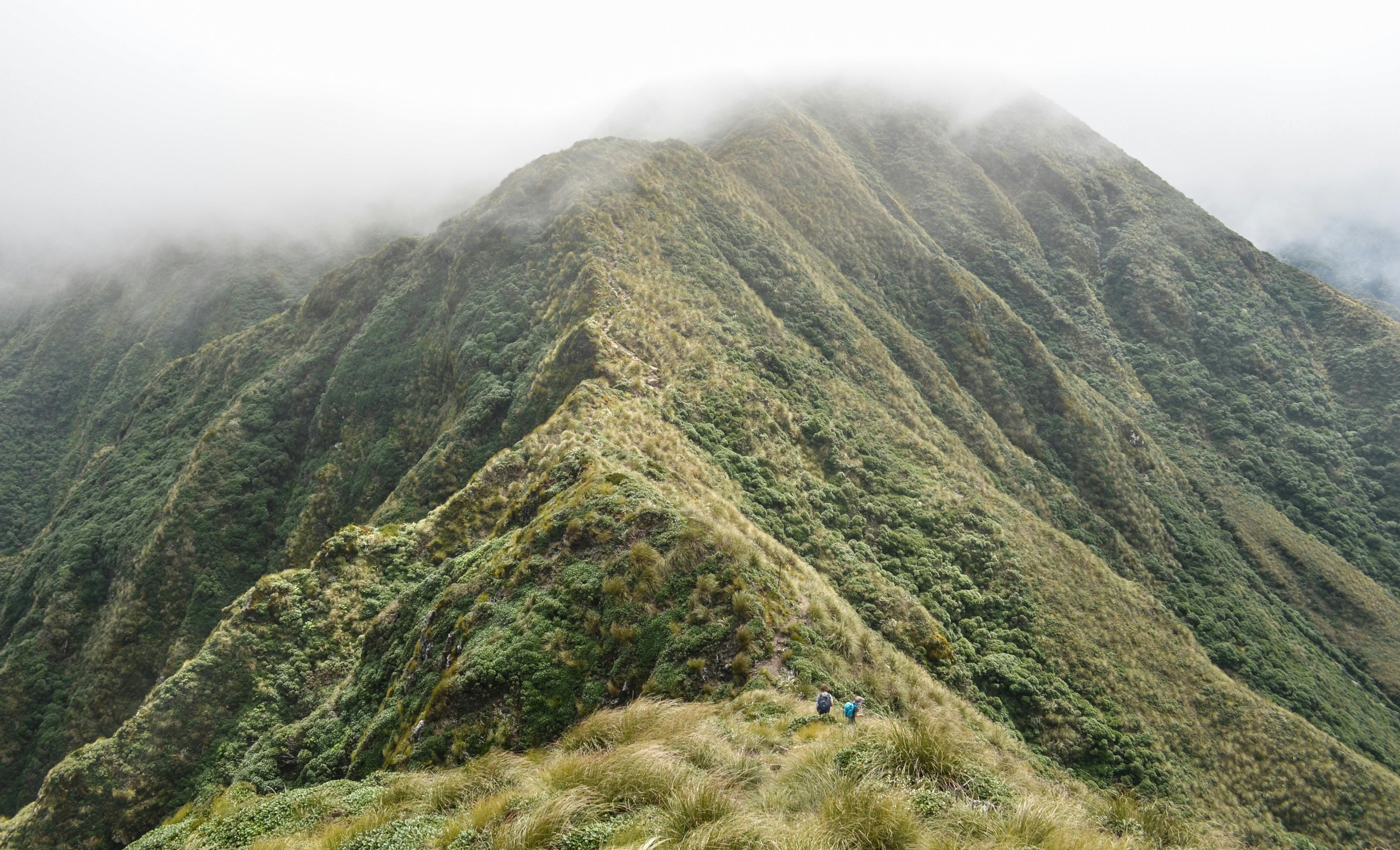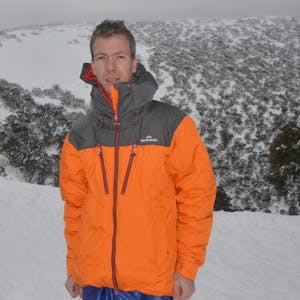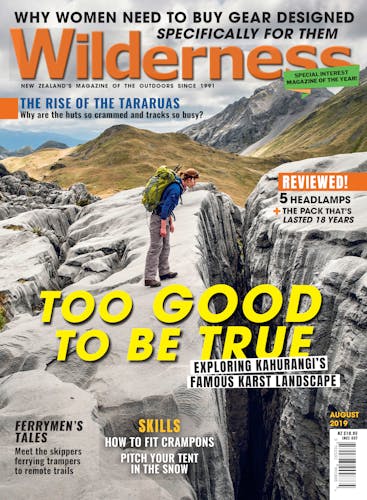No longer in the shadow of the great South Island parks, the Tararuas is practically bursting at the seams with trampers.
There are certain sounds you expect to hear when approaching Waitewaewae Hut in Tararua Forest Park. The steady rush of the Otaki River, for example. And certain sounds you don’t, such as a shrill, Australian-accent, welcoming your dog to the hut. But this is exactly what my uncle Andrew got last year when he and his tan-coloured cattle dog Sharni were greeted at the hut by an excited man strangely proclaiming, “Eats a dean-go!”
Andrew didn’t know what to make of this sound at first until he realised the man was actually trying to say, ‘It’s a dingo!’
When my uncle told me this story, I listened with interest. He added that Waitewaewae Hut was full that night, and the night after. Along with the Australian, there were Americans, Germans and many other Kiwis. He had been going to Waitewaewae Hut for more than 20 years and had never seen anything like it; usually it was empty. I felt it was my duty to break the news to him that he was unlikely to have Waitewaewae Hut to himself ever again, at least over the summer months. That’s because the hut is on the Te Araroa Trail.
For local trampers looking to avoid the crowds in the Tararuas, it should be pretty easy, though. Stay away from the Te Araroa Trail and you’ll be right. That was the thinking when we planned our tramp to Maungahuka Hut, one of the most isolated huts in the ranges. Another reason for choosing Maungahuka was the chance to take on the Tararua Peaks and the 25m ladder between them. For my son Dorian, aged 10, and second cousin Finley, 11, this unexpected infrastructure was a major enticement. For my vertigo-suffering partner Karen, it was most certainly not. My uncle Bruce was a veteran of the ladder and knew that a trip to Maungahuka Hut always brought some kind of drama.
We met our first Te Araroa walkers before we’d even tied up our boots, at the car park at Otaki Forks. The trio was heading south towards Waikanae and Wellington and told us how happy they were to be tramping in the bush after long stretches in the upper North Island walking along roads. We wished them good luck and congratulated ourselves on our good choice of route, avoiding Te Araroa and the crowds. How wrong that would prove to be.
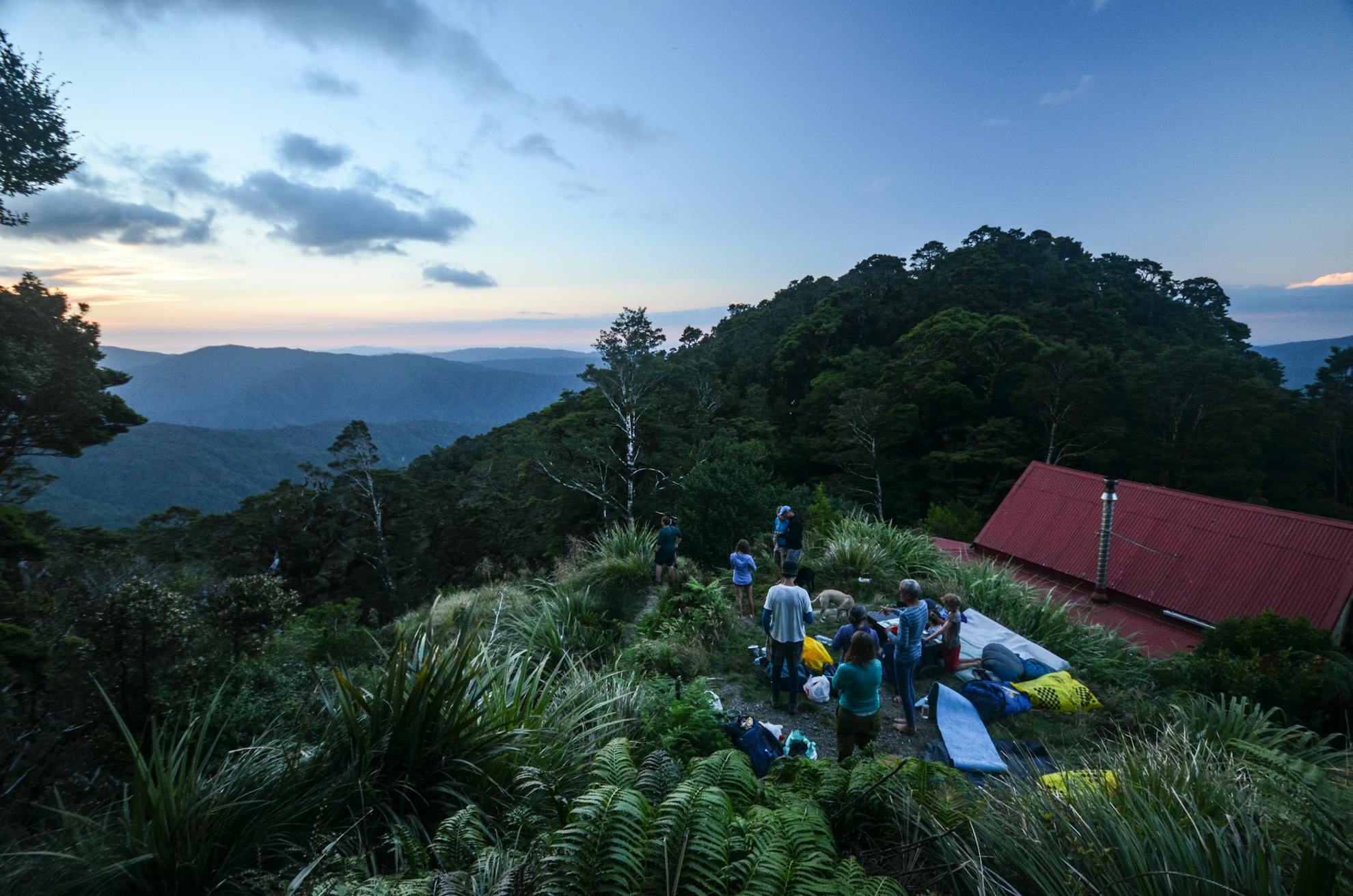
It always surprises me how exhausting the track to Field Hut can be when you’re carrying heavy first-day packs and the sun’s out. It’s three hours to the hut and the first hour of that is in the open, climbing a zigzag track through shrub, bracken and pockets of flaming rata. It’s also by far the steepest section, and we were experiencing a most unusual Tararua malady: heat stress. We took many breaks to strip off sweat-soaked tops and hang them on branches to dry.
Field Hut was lunch before two-and-a-half hours of steady climbing to Kime Hut; the last couple of kilometres now marked with tall, blue, fog-defying snow poles and large, unambiguous signs, in recognition of how disorienting and deceptively dangerous this area around Bridge Peak is.
We spent the afternoon in the sun at the new Kime Hut, at 1400m the highest hut in the Tararuas. We’d somehow reserved enough energy to climb nearby Field Peak and watch a spectacular sunset over the South Island. As often happens at evening in the mountains, the clouds that had smothered the land below lifted and the next day’s route along the Main Range was presented almost ceremoniously, displayed in warm, orange light and softened by collapsing shadow. We let it fade to black and returned to the hut for the night, already eager for the morning.
It was clear early next day, but clouds started gathering below us as we plunged off Bridge Peak onto the Main Range, and we experienced the bizarre sensation of climbing down into clouds.
The track was well-worn, but I was still surprised when we met a group of trampers coming towards us. I was even more surprised to learn they were doing the Te Araroa Trail.
“But the trail doesn’t come this way,” I said, trying not to sound too accusatory.
“We know,” one of them replied. “But we decided sticking to the Main Range would be more interesting than going down to Waitewaewae and out through the bush.”
They were undoubtedly right about that, and I did in a way feel glad that they were seeing the best bits of this great forest park I’m proud to call my stomping ground. But as we walked on, I found myself thinking that maybe something had changed in the Tararuas. Were our opportunities for solitude shrinking?
Near the top of McIntosh, I took note of where a track branches down a ridge, leading to Penn Creek Hut, a classic six-bunker near the head of a feisty creek that feeds into the Otaki River. This was our planned destination for the next day. But the pressing concern was to now negotiate the climax of the trip, the Tararua Peaks and the ladder. As if on cue, the clouds dissipated as we approached their unmistakable hulk.
Nervous energy propelled us quickly to the base of the first peak, where we met our first obstacle, a feature I had dubbed ‘the cliff face’ from when I was last here, 17 years ago. It was something of a Hillary Step, an unavoidable rock protrusion that requires nerve, strength and dexterity to scale. By helping each other find footholds we got up it unscathed and were ready for whatever the peaks would throw at us next, which we all knew full well was the ladder.
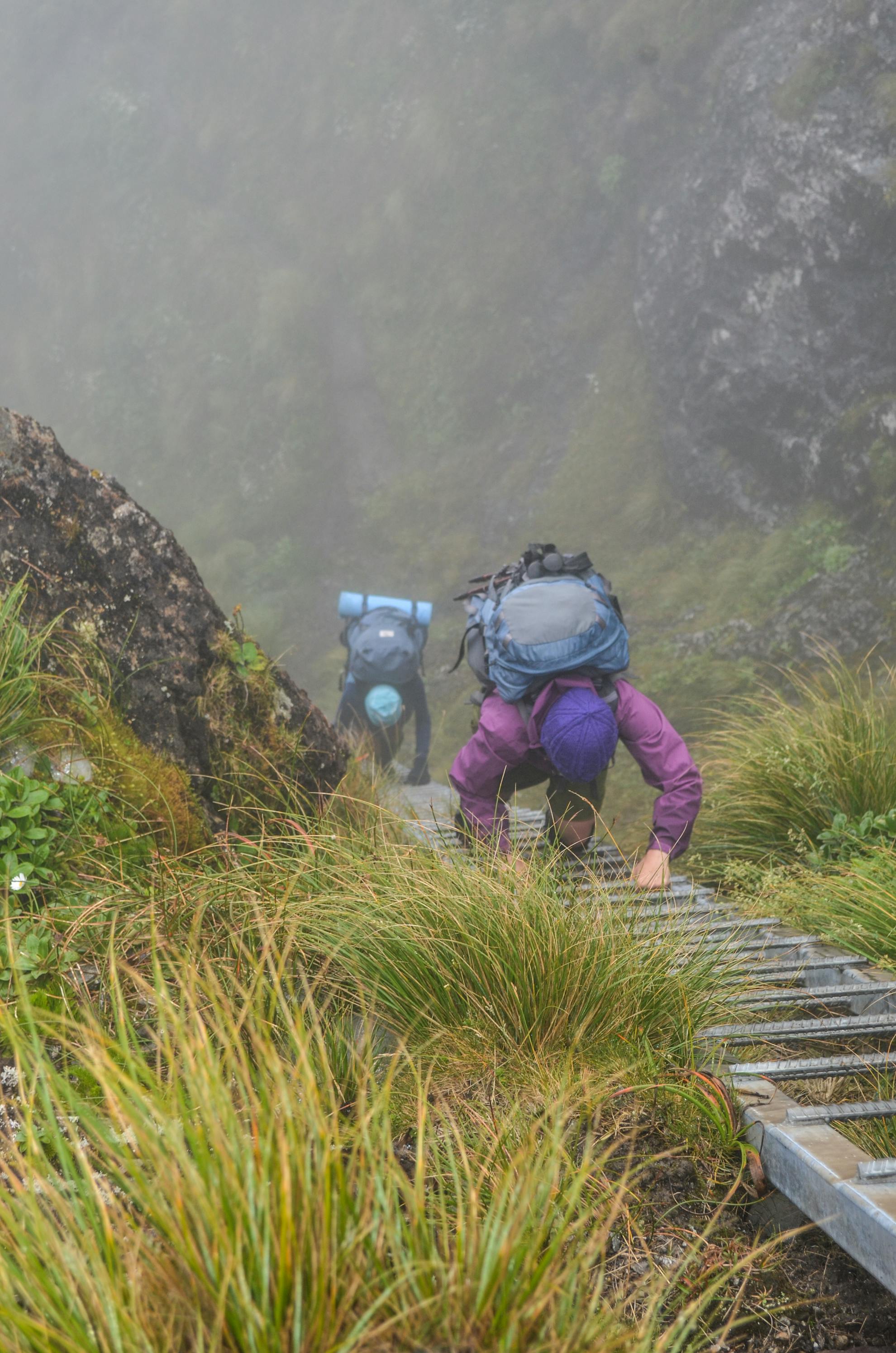
I’d first descended what was then known as the ‘chain ladder’ – situated in an otherwise impassable notch between the two Tararua Peaks – in the late 1990s. Strung with a chain of aluminium rungs, it was an experience you don’t forget. We must have been pretty fearless back then because I remember Andrew carried my dog down the ladder under one arm. The chain ladder was replaced in 2002 by a solid, galvanised steel ladder, taking some of the excitement away. The ladder is actually the easy part. More difficult is the ascent of Tuiti just before it, followed by a cable-aided descent of a slippery rock-face. Karen found this part the scariest and fought jelly-legs all the way down. The boys meanwhile were already on the ladder. Upon reaching the bottom, Karen gave a weary thumbs up, her relief dampened somewhat by the knowledge she would have to do it again on the way back.
After sidling Tunui, the track rides a few more craggy knolls before the final climb to Maungahuka peak. Near the top, we met our second group of Te Araroa trampers, who, like the first group, was sticking to the tops rather than the official trail. They told us that it wasn’t unusual to take liberties along the way. They knew walkers who had hitchhiked entire sections to avoid walking roads, or gone significantly off trail for the sake of convenience. “You tend to start off dogmatic,” one of them said, “thinking you’ll walk every step till Bluff. But it’s hard and the logistics wear you down. Then you meet people who have other plans and fall in with them and all of a sudden you’re kind of making it up as you go. But you’re still doing Te Araroa.”
Maungahuka Hut sits on a bench next to a large tarn and must be the best-situated hut in the Tararuas. The current hut replaced an old Forest Service six-bunker in 2006 and while the addition of a deck overlooking the tarn is a nice touch, I must confess the new hut left me cold, and not only because there’s no heating. The walk from Kime Hut had taken us seven hours, much longer than the 4-5 hours indicated on signposts, and sleep came easily despite the chill.
We woke to zero visibility, stinging showers and a stiff wind. There was no way we could tramp back over the peaks and get down to Penn Creek in these conditions, especially with the kids. We decided to wait and hope for a clearance. To pass the time, we played Wheel of Fortune using a spinning fan from a long-drop that was lying in the hut. For prizes, we cut out advertisements for swish gear from tramping magazines, including Wilderness (apologies, Ed). The game engrossed us for several hours; so long in fact that we failed to notice the weather had improved. Suspending proceedings, I took a walk back up the track to check conditions. It was still cold and claggy, but the wind had dropped. We could probably make it to Penn Creek, but should we take the risk?
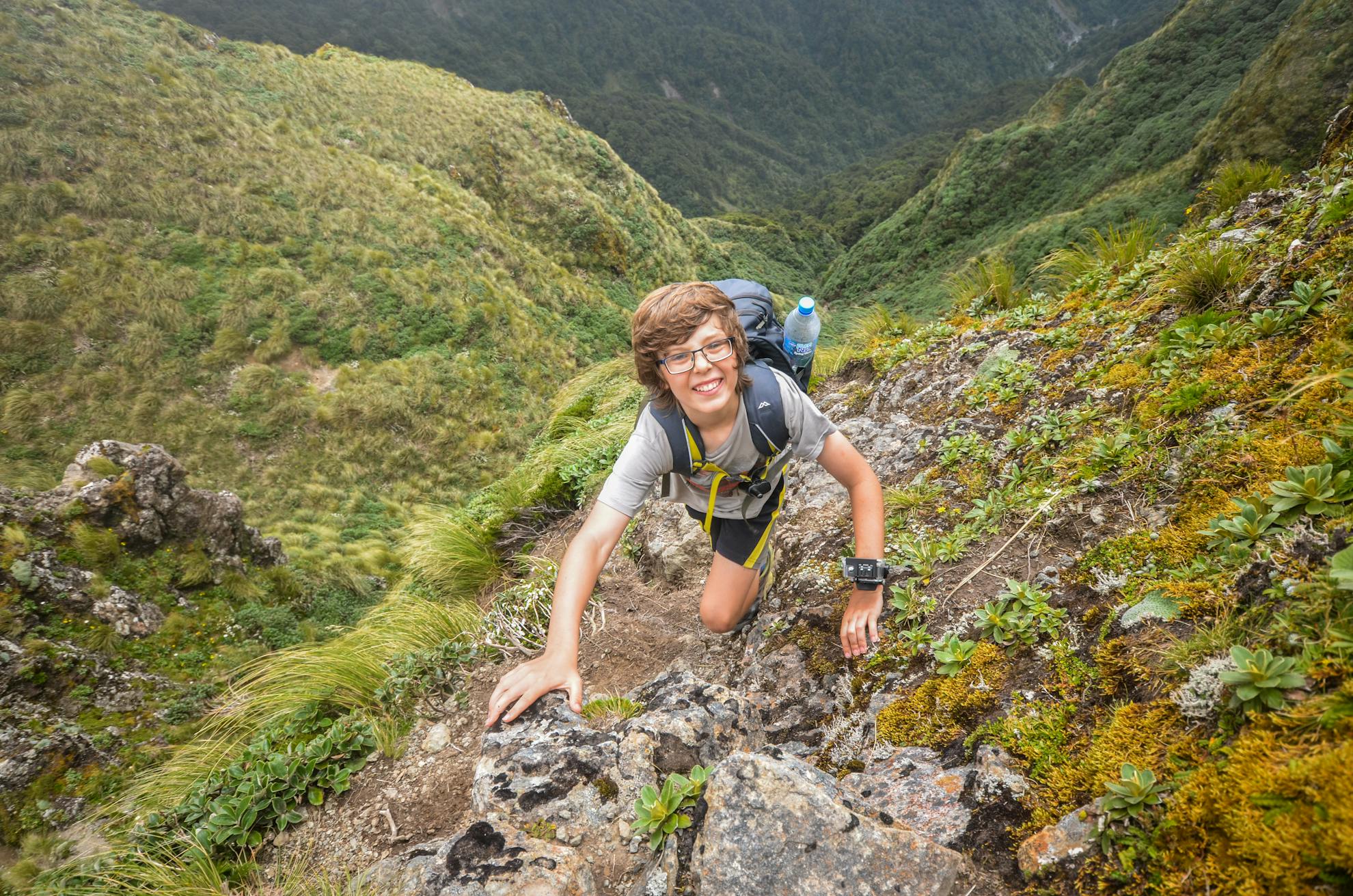
Bruce was in favour of going. Karen wanted to stay. She said she was prepared to live at Maungahuka Hut for the rest of her life if it meant never having to go over the Tararua Peaks again. The dangers of leaving were that we would run out of daylight should we encounter problems going back over the peaks, and none of us knew the state of the little-used track down to Penn Creek Hut. In the end, we decided to err on the side of caution and stay another night.
Day three at Maungahuka Hut started as drearily as day two. We had planned to meet family at Field Hut that night, which meant a long walk retracing our steps along the Main Range. Karen voted for a bail-out to Neil Forks Hut but an executive decision was made to proceed as intended to Field Hut.
Everyone put on raincoats except for Bruce, who trusted the forecast so much he hadn’t brought one. Five minutes into the walk, Dorian was complaining of cold. We kept the kids moving quickly up the steep rock faces of the Tararua Peaks. They were natural climbers, and on the tricky bits I urged them not to take it slow but to scramble without stopping as I followed in their fall zone below, hoping their instincts would deliver them foot and finger holds. The ladder proved no problem but Karen was sick with worry about descending the cliff face she knew was waiting.
I got there first and somehow made it down with my pack. The boys came next and I guided their feet into position. For Karen, it was a terrifying but necessary form of torture. As we set off again she was walking for a few minutes with a huge, involuntary smile, the flood of relief surging through her knowing that the dangerous bits were behind us now and all that remained was five or six hours of trudging. “Trudging I can do,” she said, understating her considerable gumption in getting over the dreaded Tararua Peaks twice.
We trudged back over the dips and bumps of the Main Range and along the way, the sun came out. We met a group of trampers coming the other way who were heading to Penn Creek Hut, just as we had intended to do the day before. They told us they were going to climb back onto Table Top and spend the night at Field Hut, where they had planned to meet friends. As we neared the climb to Field Peak I noticed a single tramper behind us, coming up fast, twin walking poles propelling him uphill like a cross-country skier. He was young and slight, and when I asked him where he had come from his answer left me for dead. “I left Putara Road at 6pm last night.” Putara Road was near Eketahuna, at the far north-eastern corner of the ranges. How on Earth…?
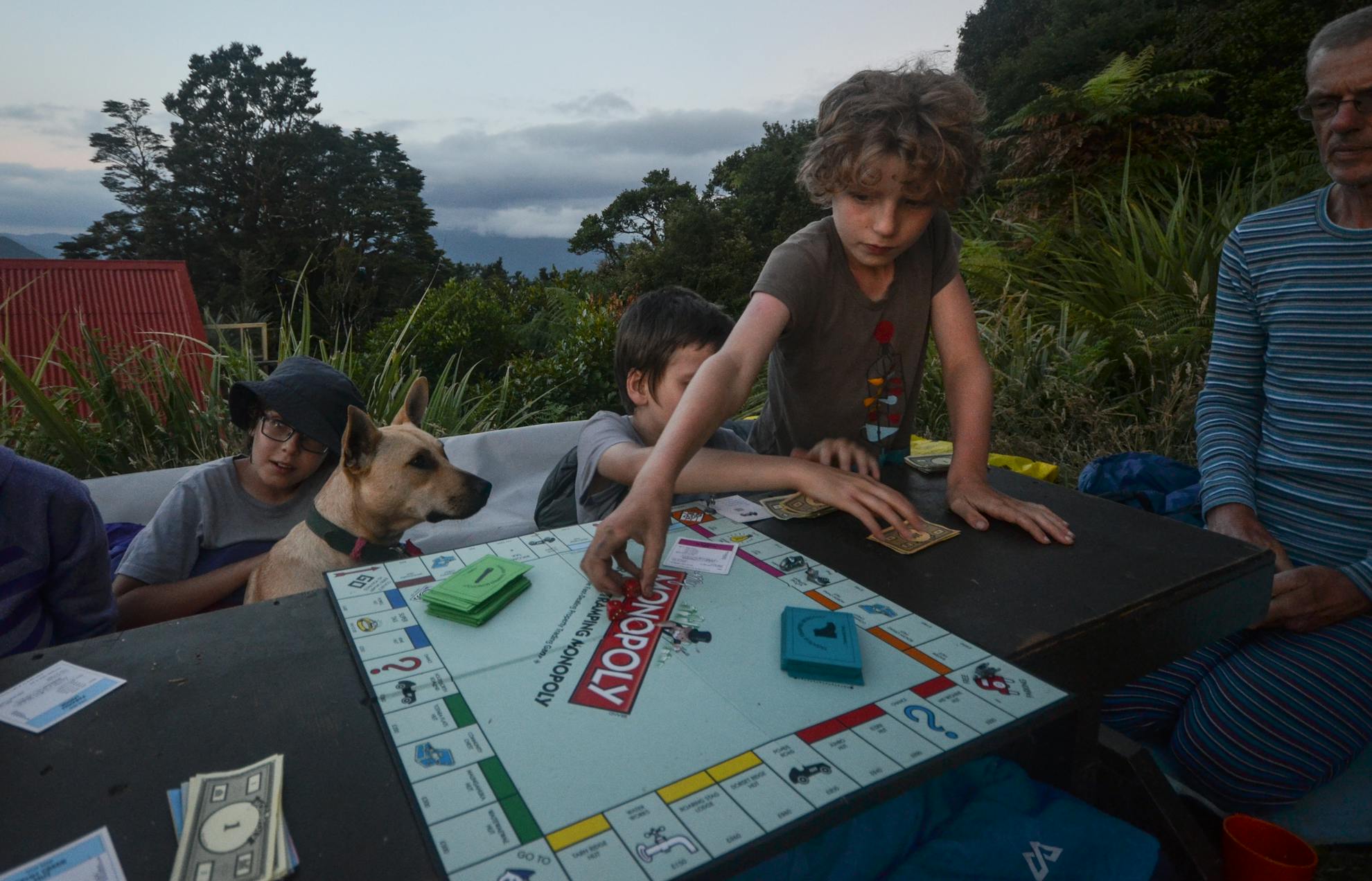
Then it clicked: he must be doing the famed ‘SK’ 24-hour challenge, where you try to run or walk the entire length of the Tararuas in 24 hours.
He confirmed this was true, in the process also confirming he was a complete lunatic. But we wished him well and watched in awe as he powered up the mountain, his eyes set on Kaitoke and, I would imagine, a jolly good lie down.
The next party we met were a couple heading to Maungahuka Hut. We filled them in on the route ahead and bade them farewell.
It was a killer climb to the summit of Field Peak, but the summit brought a kind reality: from here until the end of the tramp it was all downhill.
Descending towards Table Top, we caught sight of a figure in the distance accompanied by a dog. It looked suspiciously like a dean-go. Dorian squinted, then called out, “It’s Andrew and Sharni!”
The reunion was a wonderful moment, not only because Andrew had brought the adults a can of gin and tonic each. He’d also taken the liberty of securing two mattresses for us at Field Hut, just in case it filled up by the time we arrived.
His foresight was bang-on. When we arrived, every mattress was taken and parties were still turning up. We hauled our two mattresses onto the helipad above the hut and set up a makeshift camp. It was a gorgeous spot with a view over Kapakapanui to the west and native bush green against the hut’s dark red roof. An hour later, Finley’s mum, dad and little brother arrived. We broke the news that our night at Field Hut had turned into a night at Field Hut helipad, but they didn’t mind in the slightest.
For the rest of the afternoon, the hut hummed with activity. People kept arriving and after finding the hut full some decided to press on up to Kime Hut. Later on, word arrived that Kime Hut was also full and people were sleeping on the floor. It was clear that the popularity of the Tararuas had spread far beyond Te Araroa. None of the parties at Field or Kime that night were doing the trail; they were simply enjoying a weekend in the mountains.
Our camp on the helipad was getting festive. Sunset was magical and I was fairly certain we were the only trampers clearing space on a bench and setting a game of Tararua Tramping Monopoly. I had the game custom made a few years ago, but this was the first time it had been played in the Tararuas. We must have made a strange sight: eight people and a dog sprawled on a helipad furnished with two mattresses, a tarpaulin, a bench seat and a full-size monopoly board.
We slept under the stars and woke to drenched sleeping bags, not from rain but dew. No one minded though, and we hung them to dry while making hot drinks and watching sunlight caress the tops of the trees and then sink its golden warmth slowly down towards us. As the steam rose from my mug I thought back to the many different people we had met on this tramp and smiled. No longer sulking lonely in the shadows, the Tararua Ranges has come out to shine.





